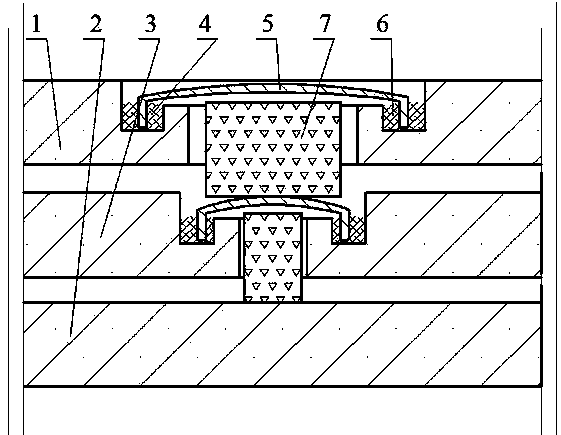Placement structure for getter of double-vacuum layer glass and manufacturing method of placement structure
A technology of vacuum glass and getter, which is applied in glass forming, glass reshaping, glass manufacturing equipment, etc. It can solve the problems of complex encapsulation and placement of getter, difficulty in placing getter, and small getter dose and other problems, to achieve the effect of simple structure, low cost and high vacuum degree
- Summary
- Abstract
- Description
- Claims
- Application Information
AI Technical Summary
Problems solved by technology
Method used
Image
Examples
Embodiment
[0042] Embodiment: Referring to the accompanying drawings, the vacuum glass is composed of an upper glass 1, a lower glass 2 and a middle glass 8. A through hole is respectively drilled on the upper glass 1 and the middle glass 8 to form a suction port, wherein the through hole on the upper glass 1 is larger than the middle glass. A through hole on the glass 8; on the upper surface of the upper glass 1 and the middle glass 8, a hollow drill is used to make a U-shaped sealing groove 4 concentric with the air inlet, and the inner edge of the sealing groove 4 is lower than the upper surface of the upper glass 1. surface; respectively make a seal cover 5 according to the size of the seal groove 4, the edge of the seal cover 5 can be inserted in the seal groove 4, the height of the seal cover 5 is lower than the upper surface of the upper glass 1, the gap between the seal cover 5 and the seal groove 4 The space between them is an air extraction channel; temper the upper and lower gl...
PUM
 Login to View More
Login to View More Abstract
Description
Claims
Application Information
 Login to View More
Login to View More - R&D
- Intellectual Property
- Life Sciences
- Materials
- Tech Scout
- Unparalleled Data Quality
- Higher Quality Content
- 60% Fewer Hallucinations
Browse by: Latest US Patents, China's latest patents, Technical Efficacy Thesaurus, Application Domain, Technology Topic, Popular Technical Reports.
© 2025 PatSnap. All rights reserved.Legal|Privacy policy|Modern Slavery Act Transparency Statement|Sitemap|About US| Contact US: help@patsnap.com

